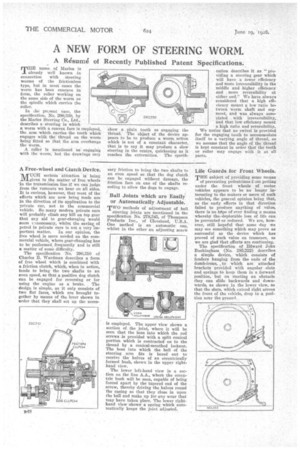A Free-wbeel and Clutch Devire.
Page 74

If you've noticed an error in this article please click here to report it so we can fix it.
MUCH serious --attention is being given to the matter Of free wheels In the transmission line if we can.judge from the rumours we hear on all sides. It is curious, however, that most of the efforts which are now being made are in the direction of its application to the private car, not to the commercial vehicle. So many modern private cars -will probably climb any hill on top gear that any aid to gear-changing would seem innecessary, -whilst the saving., of petrol in private cars is not a very important matter. In our opinion, the free wheel is more needed ou the commercial vehicle, where gear-changing has to be performed. frequently and is still a matter of some difficulty.
The specification No. 290,310 of Charles B. Wardmau describes a form of free wheel which is combined with a friction clutch, which, when in action, tends to bring the two shafts to an even speed, so that a positive dog clutch can be engaged for reversing or for using the engine as a brake. The design is simple, as it only consists of two flat faces, which are brought together by means of the lever shown in order that they shall set up the neces sary friction to bring the two shafts to an even speed so that the dog clutch can be engaged without damage, the friction face on one of the shafts receding to allow the dogs to engage.
Ball Joints .which are Easily or Automatically Adjustable.
TWO methods of adjustment of ball steering joints are mentioned in the specification No. 278,345, of Thompson Products Inc., of Cleveland, U.S.A. One method is an automatic one, whilst in the other an adjusting screw is employed. The upper view shows a section of the joint, where it will be seen that the boss into which the rod screws is provided with a split conical portion which is contracted on to the thread by a conical-mouthed locknut. The boss into which the ball of the steering arm fits is bored out to receive the halves of an eccentrically formed bush, shown in the upper righthand view.
The lower left-hand view is a section on the line A.A., where tho eccentric bush will be seen, capable of being forced apart by the tapered end of the screw, thereby driving the halves round the casing so that they close in upon the ball and make up for any wear that may have taken place. The lower righthand view shows a spring which automatically keeps the joint adjusted.
-Life Guards for Front Wheels.
THE subject of providing some means of preventing pedestrians f.-oni getting under the front wheels of motor vehicles appears to be no longer interesting to the makers or users of such vehicles, the general opinion being that, as the early efforts in that direction failed to produce anything of value, there is no htipe of ever finding a means whereby the-deplorable loss of life can he prevented or reduced. We are, however, still hopeful that some day we may see something which may prove as successful as the device which has proved of such value on tramcars, so we are glad that efforts are continuing.
The specification of Edward John Buckingham (No. 285,222) describes a simple device, which consists of fenders hanging from the ends of the dumb-irons„ to which are attached brackets provided with angular slots and springs to keep them in a forward position, but on meeting an obstacle they can slide backwards and downwards, as shown in the lower view, so that the slats, which extend right across the front of the vehicle, drop to a position near the ground._




















































































































